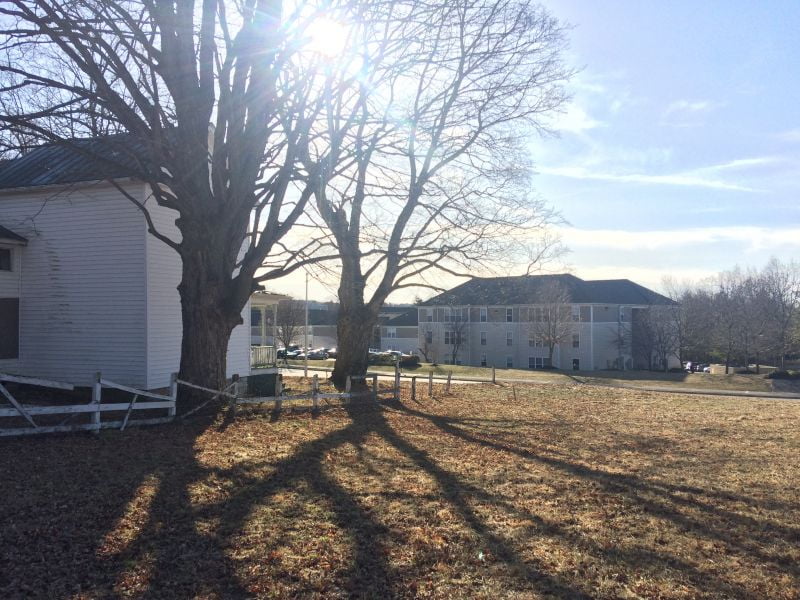In a four-to-three vote, the Blacksburg Town Council approved the rezoning of 1222 Patrick Henry Drive, clearing the way for the building of a multi-story, high-density apartment complex. The 4.25-acre parcel of grass, collapsing farmhouse and old trees is surrounded by sprawling student apartment blocks, but backs up to a long-established neighborhood of quiet streets and single-family homes.

Historic farm house and old trees surrounded by student apartments will now contribute to high density development.
The worries voiced by residents of those homes in this week’s public hearing reflected the struggle many towns have protecting adjacent communities from new development. But, as the university grows and Town more closely abuts Gown, Blacksburg town council’s close vote reveals the speed at which Blacksburg is changing and how the town will have to adapt boldly to stay ahead of that change.
In a two-hour meeting, citizens of the Shenandoah community in red shirts, red sweaters and babies in red onsies spoke of their fears of noisy, drunken, transient students.
“On a football weekend, I can’t take my dogs for a walk on the path for all the broken glass. It doesn’t add to the neighborhood,” John Grant, a Shenandoah neighbor said.
Characterizing the development as “a dormitory,” speakers cited the need for housing affordable to young professionals and the maintaining the Comprehensive Plan designation of R-5 that would support townhouses or duplexes.
Adamant against rezoning, citizens said they were content with R-5, despite relinquishing the opportunity to suggest proffers.
As it stands, following more than a year of hearings, proffers and neighborhood meetings, local developer, Green Valley Building, proffered Earth Craft-certified building, an approved walking path, a bus pull-off and a rear setback that is four times farther away than a by-right requirement, and on-site management to reduce undesirable behavior by residents.
Many were frustrated that the Comprehensive Plan was not being adhered to.
“It say, “The major land-use up to and including 10 dwelling or 20 bedrooms/acres which ever is less. Fifty-one bedrooms is not compliant, not close, not even in the ballpark. People are counting on the plan to be followed or looked at seriously,” Eileen Bowman, a Shenandoah resident said.
Others, supporting the development, said it provided amenities and architecture attractive to young professionals, a demographic that finds price points difficult to meet in Blacksburg, and far from being a “dormitory” called it good looking.
In the end, three council people spoke against the development, three spoke for
John Bush said he was “running up against the wall for my tolerance for the PR process.”
But in her comments Mayor Leslie Hager-Smith asked that the neighborhood and the town as a whole prepare to be bold and enact their purported values to help the town develop wisely.
“My Spidey sense tells me,” she said, “that there is not sufficient recognition in this room of the how quickly growth is overtaking us. We seem to be plodding through this rezoning as if it were business as usual. But this proposal is not the usual fare. This comes to us at a pivotal moment in our history. I believe this is an opportunity to demonstrate our professed values and help prevent sprawl.”
Hager-Smith recalled her experience living in Seattle, Washington and Athens Georgia, a university town comparable to Blacksburg, as examples of development that did not respond nimbly or plan for unexpected growth and were entirely transformed by it.
“It happens fast,” she said.
While best development practices put people where they work and study, near service sand amenities, protecting land and water resources are the real reason to approve this development, council members supporting the rezoning said.
“The best reason is that it protects the view-shed, water quality, wildlife habitat and the lands that surround us. I know all of you have a view of that and you cherish it as I do.”
“I fault no one for whom these changes are unwelcome. But they are happening and they’re happening quickly,” Hager-Smith said. “I sincerely believe that we’ll get much better results by engaging in ways that will get us the kind of development that we, as a progressive college town, claims to value.”
No matter how responsible the development practices are, they will demolish a century-old farm house and some very old trees.
One person stood to mention the historic nature of the house on the property and its trees.
“That’s the Reynolds house, there are parts of the original family home underneath” he said. “I don’t want to see the loss of house. I’d like to see them fix the home make it part of a nice community. It was there before the town existed. Around the time the English got hauled off by the Cherokees.”
Justin Boyle, CFO of Green Valley Builders’ said the development does intend to remember historic land use.
“So, our intentions are to preserve some of the trees on site. The trees that have to come down we’ll be able to reuse them as benches and accent pieces in the property. The house is in pretty bad shape, but we do have plans to try to salvage some of the building materials. That’s our intention 100 percent. We’re looking forward to trying to utilize some of those things. We’ll leave as many as we can.”



